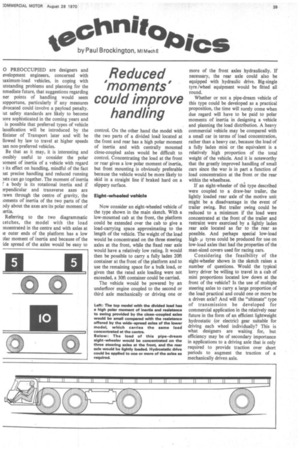t eelnitaz ics by Paul Brockington, miMechE
Page 41

If you've noticed an error in this article please click here to report it so we can fix it.
Reduced 'moments' could improve handling
0 PREOCCUPIED are designers and evelopment engineers, concerned with taximum-load vehicles, in coping with utstanding problems and planning for the nmediate future, that suggestions regarding ner points of handling would seem iopportune, particularly if any measures dvocated could involve a payload penalty. ut safety standards are likely to become tore sophisticated in the coming years and is possible that preferred types of vehicle lassification will be introduced by the linister of Transport later and will be llowed by law to travel at higher speeds tan non-preferred vehicles.
Be that as it may, it is interesting and ossibly useful to consider the polar ioment of inertia of a vehicle with regard ) its effect on handling, mindful of the fact iat precise handling and reduced running )sts can go together. The moment of inertia r a body is its rotational inertia and if erpendicular and transverse axes are rawn through the centre of gravity, the Loments of inertia of the two parts of the )dy about the axes are its polar moment of Lertia.
Referring to the two diagrammatic (etches, the model with the load mcentrated in the centre and with axles at ie outer ends of the platform has a low Mar moment of inertia and because of the ide spread of the axles would be easy to control. On the other hand the model with the two parts of a divided load located at the front and rear has a high polar moment of inertia and with centrally mounted close-coupled axles would be difficult to control. Concentrating the load at the front or rear gives a low polar moment of inertia, but front mounting is obviously preferable because the vehicle would be more likely to skid in a straight line if braked hard on a slippery surface.
Eight-wheeled vehicle Now consider an eight-wheeled vehicle of the type shown in the main sketch. With a low-mounted cab at the front, the platform could be extended over the cab to give a load-carrying space approximating to the length of the vehicle. The weight of the load would be concentrated on the three steering axles at the front, while the fixed rear axle would have a relatively low rating. It would then be possible to carry a fully laden 20ft container at the front of the platform and to use the remaining space for a bulk load, or given that the rated axle loading were not exceeded, a 30ft container could be carried.
The vehicle would be powered by an underfloor engine coupled to the second or third axle mechanically or driving one or more of the front axles hydraulically. If necessary, the rear axle could also be equipped with hydraulic drive. Big-single tyre /wheel equipment would be fitted all round.
Whether or not a pipe-dream vehicle of this type could be developed as a practical proposition, the time will surely come when due regard will have to be paid to polar moments of inertia in designing a vehicle and planning the load distribution. A heavy commercial vehicle may be compared with a small car in terms of load concentration, rather than a heavy car, because the load of a fully laden mini or the equivalent is a relatively high proportion of the total weight of the vehicle. And it is noteworthy that the greatly improved handling of small cars since the war is in part a function of load concentration at the front or the rear within the wheelbase.
If an eight-wheeler of the type described were coupled to a draw-bar trailer, the lightly loaded rear axle of the motive unit might be a disadvantage in the event of trailer swing. But trailer swing could be reduced to a minimum if the load were concentrated at the front of the trailer and restraint were exercised by a lightly laden rear axle located as far to the rear as possible. And perhaps special low-load highp tyres could be produced for use on low-load axles that had the properties of the man-sized covers used for racing cars.
Considering the feasibility of the eight-wheeler shown in the sketch raises a number of questions. Would the typical lorry driver be willing to travel in a cab of mini proportions located low down at the front of the vehicle? Is the use of multiple steering axles to carry a large proportion of the load practical and could one or more be a driven axle? And will the "ultimate" type of transmission be developed for commercial application in the relatively near future in the form of an efficient lightweight hydrostatic (or electric) gear suitable for driving each wheel individually? This is what designers are waiting for, but efficiency may be of secondary importance in applications to a driving axle that is only required to provide traction over short periods to augment the traction of a mechanically driven axle.
































































































